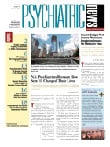This summer has marked the second phase of the all-important public commenting period in development of the fifth edition of the Diagnostic and Statistical Manual of Mental Disorders (DSM-5). This unique aspect of the DSM revision has been imperative to improving our understanding of how proposed revisions may impact the clinical care of patients. Important considerations include whether the criteria are understandable as well as accurate; whether proposed patient-reported outcome measures can be practically implemented in busy clinical settings; and whether dimensional aspects of psychiatric diagnosis, like the use of quantitative ratings of diagnostic severity, are helpful for making a diagnosis and planning treatment. Without soliciting feedback from clinicians, professional groups, mental health consumers, their loved ones, and mental health advocacy groups, we would be missing a crucial piece of the puzzle.
When APA first launched the
DSM-5 stand-alone Web site at <
www.dsm5.org> in February 2010, the intention was to provide an accessible outlet for public viewing of proposed criteria and, perhaps more importantly, to create a venue in which individuals could share with the
DSM-5 work groups their questions, concerns, and general thoughts about possible changes to our diagnostic system. The two-month period in which we gathered feedback was so successful, it was immediately clear to
DSM-5 leadership that additional requests for the public's opinion would be needed in the future as draft proposals continue to evolve toward final revisions.
Over the course of the following year, the DSM-5 work groups refined their criteria, including those in the personality disorders section; proposed dimensional measures of assessment to aid in diagnosis; and contributed to a reorganized chapter structure in which disorder categories were rearranged to better reflect advances in the science and practice of psychiatry. Thus, from May through July of this year, we again asked patients, professionals, and the public to weigh in on all of these proposed changes to DSM, and they did so enthusiastically. Since reopening the site to comments in May, we received visits from more than 125,000 individuals from 162 countries who submitted 2,120 comments and questions. The greatest number of comments was directed at the Sexual and Gender Identity Disorders Work Group, followed closely by the Somatic Symptom Disorders Work Group and the Anxiety Disorders Work Group.
The content of the feedback itself reflected a variety of concerns. Some visitors pondered the impact of specific criteria changes on a clinician's ability to make a given diagnosis—and, similarly, a patient's likelihood of receiving insurance coverage for treatment of that diagnosis. Others shared concerns about broad changes impacting the field as a whole, like that of pathologizing normal variations of human behavior and emotion. Still others provided personal accounts of their experiences as mental health consumers; a portion of these individuals wrote in support of newly proposed diagnoses that, if accepted, might improve access to care. Conversely, other individuals expressed worry that adoption of a psychiatric diagnosis would mean mislabeling a condition more appropriately considered a general medical problem, such as with disorders under the charge of the Somatic Symptom Work Group. These accounts are meaningful and give work group members information that previous revisions of DSM had less time and fewer opportunities to collect: individual perspectives from those who will use or be most affected by DSM.
Now that the second wave of public commenting has concluded, what is next? The work groups are systematically sorting through all submissions and discussing how best to integrate the feedback into their revision work. In addition to using the Web-site comments, work groups are also receiving data from the DSM-5 field trials, which will be analyzed and disseminated across the work groups and DSM-5 Task Force on a rolling basis this fall. By the end of the calendar year, the work groups will be well positioned, thanks to the Web postings and field-trial findings, to make informed decisions about revisions based on clinical as well as empirical evidence. After that time, we will host a third, and final, Website posting wherein readers will be invited to comment on the final draft criteria and revisions. This will likely take place either at the end of 2011 or at the start of 2012.
The importance of public and professional input into DSM-5 cannot be understated. The manual is first and foremost a guide for clinical care, and without understanding the subjective impact of revisions to psychiatric diagnosis and treatment, we fall short of our mission to put patients first. We appreciate all of the time and thoughtful effort that visitors to the site have contributed thus far, and we look forward to sharing our progress in developing DSM-5 as the May 2013 publication date approaches.

